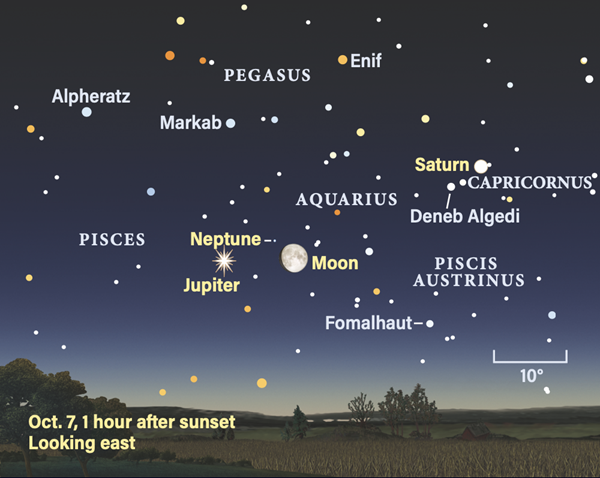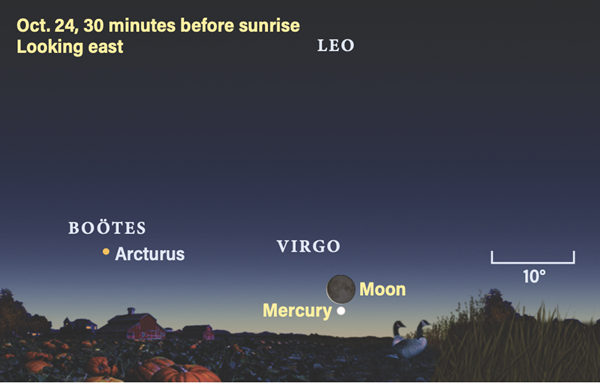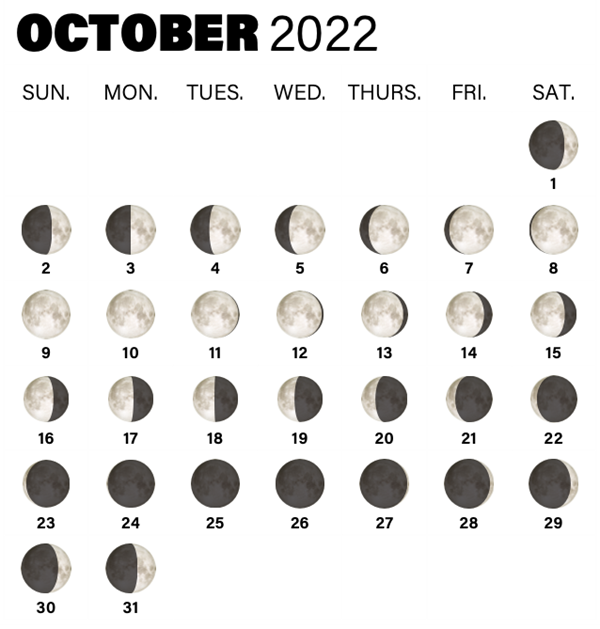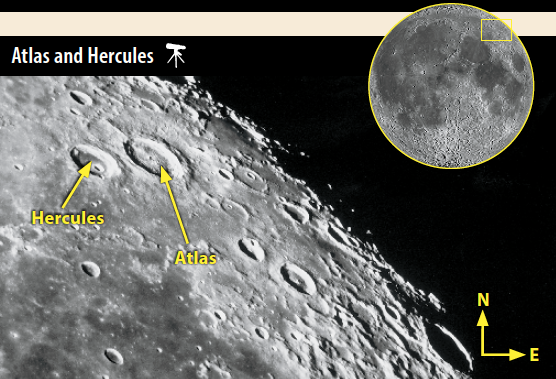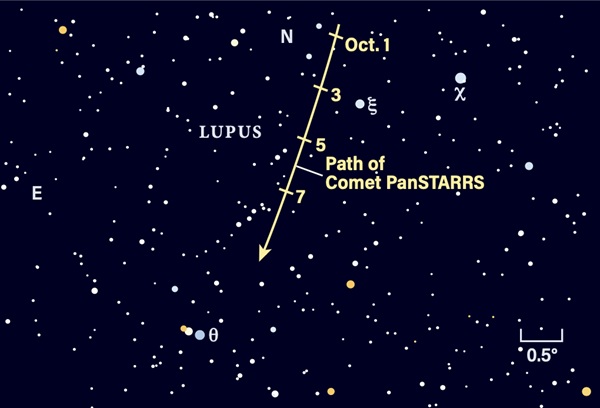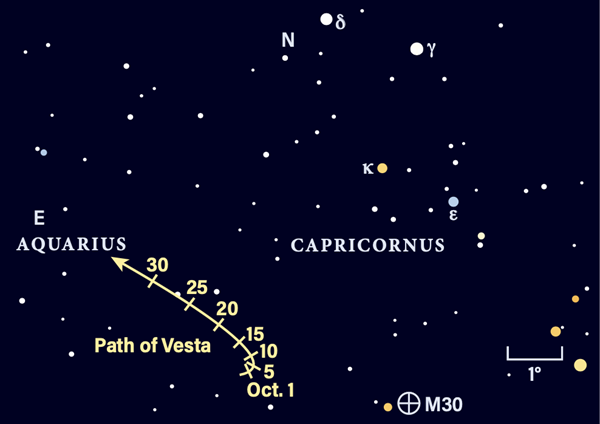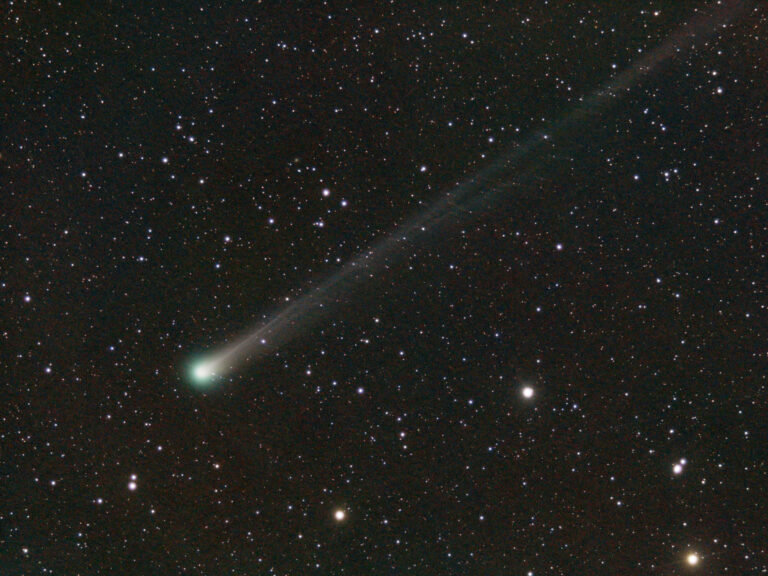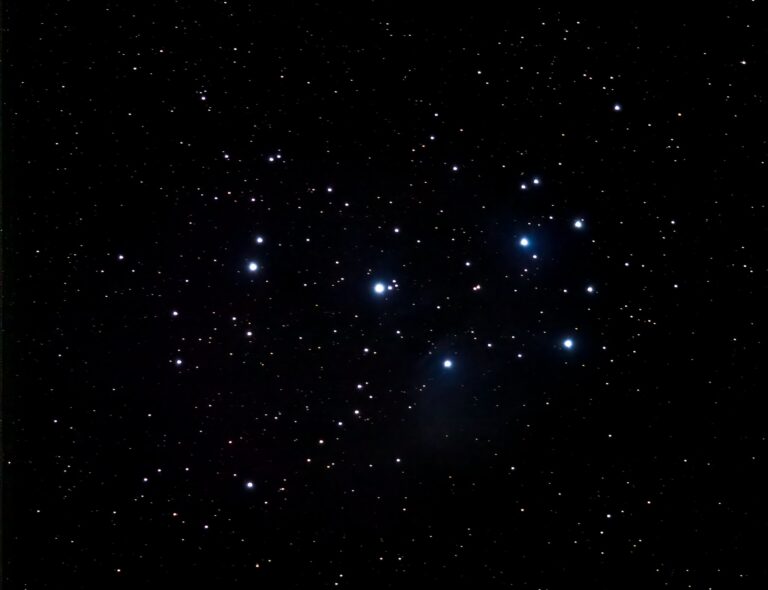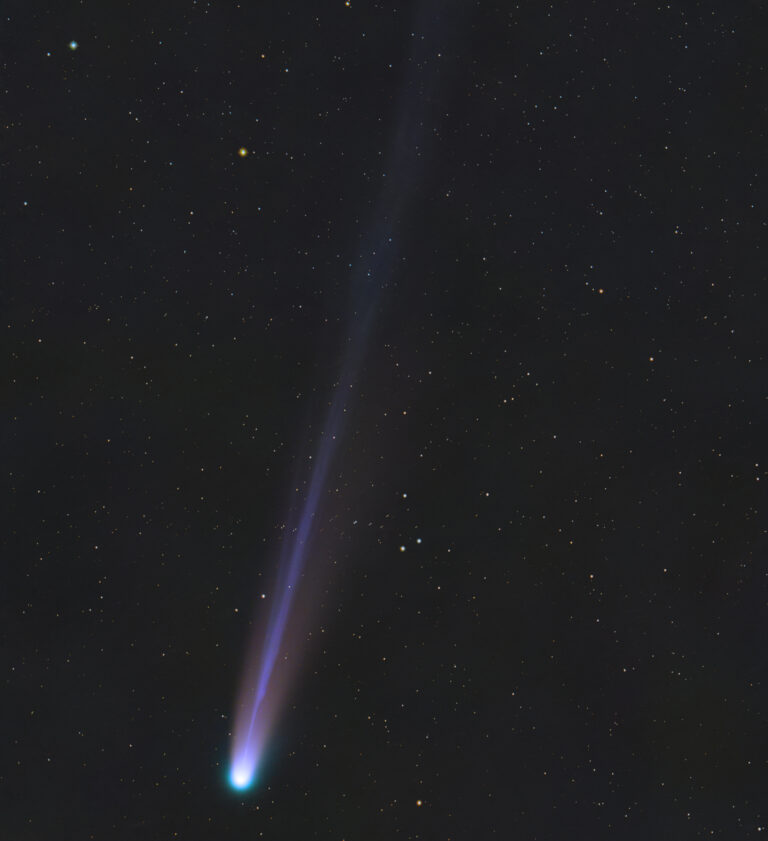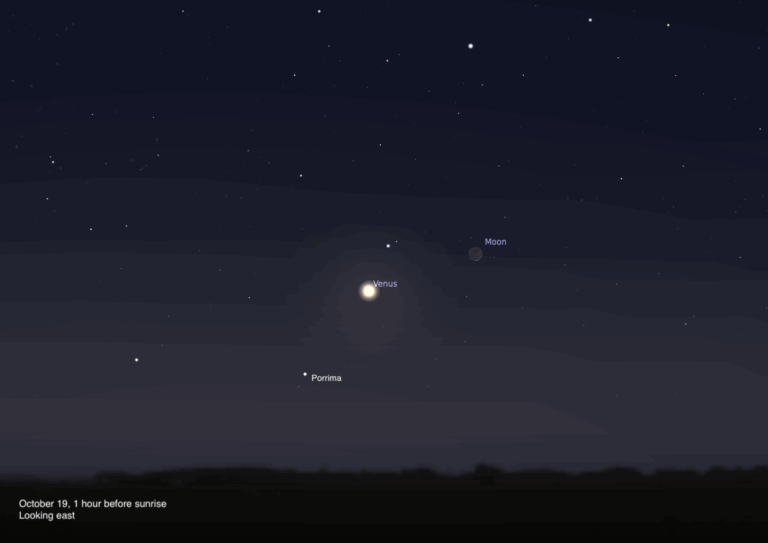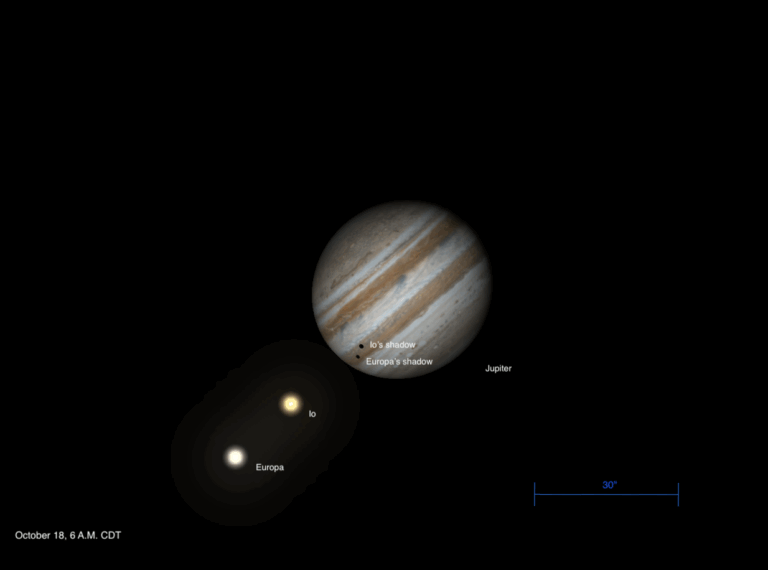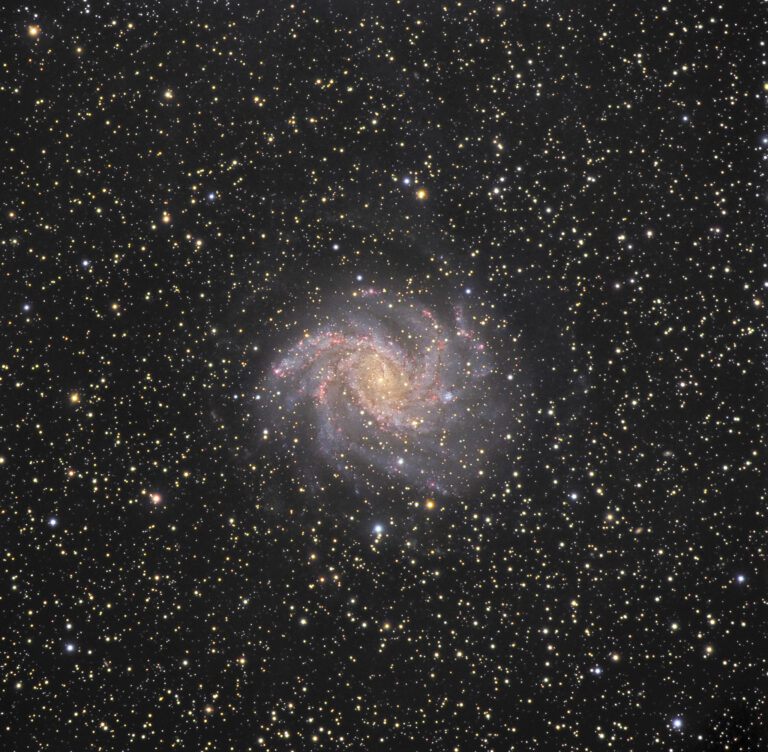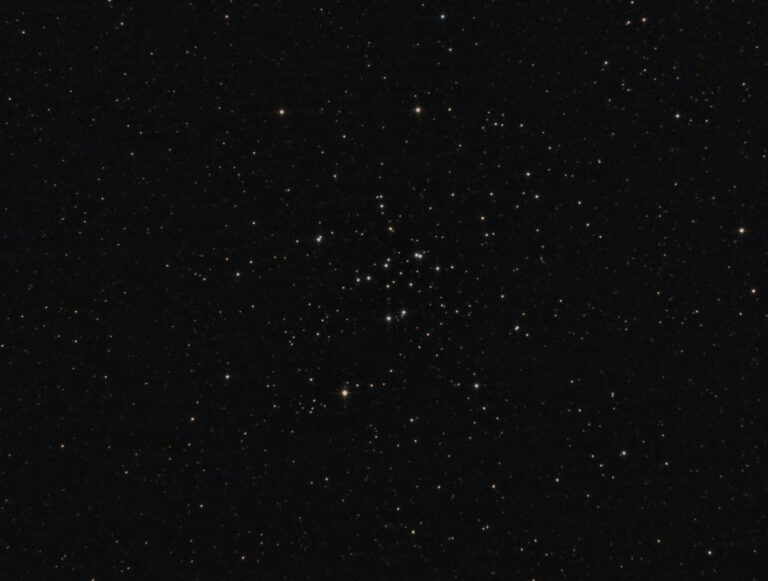Key Takeaways:
- October presents favorable viewing conditions for several planets, including Jupiter, Saturn, Neptune, and Mars, with Mars approaching opposition in two months.
- Several planetary phenomena are observable, including transits and occultations of Jupiter's Galilean moons, and a lunar occultation of Uranus (challenging) and Mercury (challenging).
- The Orionid meteor shower peaks on October 21, offering optimal viewing conditions due to a waning crescent moon.
- A partial solar eclipse will be visible across parts of Europe, Africa, Asia, and the Middle East on October 25.
Swing your telescope to eastern Capricornus for a fine view of Saturn each evening this month. It’s visible at nightfall and doesn’t set until nearly 3 A.M. in early October, and shortly before 1 A.M. at the end of the month. The ringed planet glows at magnitude 0.5, making it the brightest feature of Capricornus except when the Moon is around on Oct. 4 and 5. You’ll find Saturn a pleasant 30° high in the southern sky during the first few hours of darkness.
Saturn is elegant when viewed through a telescope at low magnification — set in a wealth of black sky, it resolves into a beautiful disk surrounded by its ring system. No one ever forgets their first view of this magnificent planet. The disk spans 18″, with its polar diameter a smaller 16″. As Earth pulls away from Saturn after August’s opposition, the disk shrinks by about 3 percent this month.
The rings span 40″ across their long axis, an overwhelming sight. Their apparent tilt to our line of sight is 15°, with their northern face sunlit.
Titan, Saturn’s largest moon, shines at magnitude 8.5 — an easy target for small telescopes. You’ll find it north of Saturn the mornings of Oct. 8 and 24, and due south Oct. 16. Fainter Tethys, Dione, and Rhea, all magnitude 10, change relative locations from night to night. Iapetus moves from an Oct. 4 inferior conjunction to reach western elongation Oct. 24, the day after Saturn reaches a stationary point on its retrograde loop. The evening of Oct. 3 in the U.S., you can spot this 11th-magnitude moon a mere 18″ southeast of the planet. By late October, Iapetus’ brighter hemisphere is facing us, increasing its magnitude to 10. You’ll find it 8′ due west of Saturn, with a trio of stars of similar magnitude to the moon’s north.
You can easily find Neptune by using Jupiter as a guide. The ice giant starts the month about 9.5° west-southwest of the brighter planet. Neptune is a month past opposition and well placed nearly all night in eastern Aquarius, a few degrees south of the Circlet of Pisces. Binoculars will reveal it about 5.5° south of Lambda (λ) Piscium. A bright gibbous Moon lies 3° south of Neptune late on Oct. 7. Neptune glows at magnitude 7.7; a telescope reveals its dim bluish disk, spanning 2″.
Jupiter is the brightest object in the evening sky aside from the Moon. It is visible all evening, shining at magnitude –2.9. It stands in southern Pisces, below the Square of Pegasus.
After opposition in late September, Jupiter maintains an apparent diameter of 50″ for a few days into October, diminishing slightly to 48″ by the end of the month. Early evening views are nice, and things only improve as Jupiter moves above 45° altitude around 11 P.M. local time in early October; this occurs progressively earlier as the month flows on.
Jupiter’s dynamic atmosphere is its main attraction. Brownish belts straddle the equator and carry additional spots and festoons across the central median in minutes. Watch for the Great Red Spot’s occasional appearance. Be patient and wait for fleeting moments of atmospheric stillness that offer the most incredible views of the gas giant.
The four Galilean moons — Io, Europa, Ganymede, and Callisto — orbit with periods of two to 16 days. Past opposition, the moons transit ahead of their shadows. A series of Europa transits followed by Io occultations occur Oct. 8, 15/16, and 22/23. Each of these is followed by an Io transit on the evenings of Oct. 9, 16, and 23.
On Oct. 8, Europa’s transit begins at 8:49 P.M., its shadow begins to transit at 9:25 P.M., and Io disappears at 10:42 P.M. (all times EDT). On Oct. 15/16, events occur in the same order at 11:03 P.M., 12:01 A.M., and 12:26 A.M. (the last two events are on the 16th for those in the Eastern time zone only). On Oct. 23, events are in a slightly different order: Europa transits starting at 1:18 A.M., Io disappears at 2:11 A.M., and Europa’s shadow slips onto the disk at 2:36 A.M. (Some or all events occur late on the 22nd in western time zones.) Also on the 22nd, Ganymede is occulted by Jupiter at 11:30 P.M. EDT.
Io and its shadow transit the day after each of the Europa events. These transits (moon, shadow) occur at 7:53 P.M. and 8:14 P.M. on the 9th, 9:38 P.M. and 10:09 P.M. on the 16th, and 11:24 P.M. (Oct. 23) and 12:05 A.M. (Oct. 24 for East Coast observers only; all times are again EDT). Note how the time between each moon and shadow transit stretches as October progresses — a feature of Earth’s changing view of the Jupiter system relative to the direction of sunlight.
The next planet along the ecliptic, Uranus, is occulted by the Moon Oct. 11/12. Uranus currently lies in the sparse regions of southeastern Aries.
Those in the northwestern U.S. will see the occultation. Others will see a near miss, with Uranus south of the Moon. It’s challenging to see magnitude 5.7 Uranus reappear near such a bright Moon, but there’ll be lots of interest. The timing of the event is heavily location-dependent but occurs around 11:45 P.M. (For example, residents of Denver see Uranus appear at about 11:52 P.M. MDT on the 11th). Observers in the eastern U.S. will see a similar event on the first day of 2023.
Uranus is approaching next month’s opposition. To find it, locate magnitude 2.5 Menkar in Cetus. Uranus stands about 12° due north of the star, slightly less than two field diameters in 7×50 binoculars. The aqua-colored planet is located between Sigma (σ) and 53 Arietis all month.
Through a telescope, try to discern the 4″-wide disk. At more than 1.7 billion miles from Earth, it’s a marvelous sight. Use higher magnifications on nights of good seeing for the best views.
Mars is a stunning object in the middle of Taurus on Oct. 1. It’s now only two months from opposition as we enter the best time to observe the Red Planet. Mars rises around 10 P.M. and brightens from magnitude –0.6 to –1.1 during the month. It forms a stunning triangle with two bright red giant stars: Betelgeuse to its south and Aldebaran to its west.
The Moon joins Mars late on Oct. 14, separated by less than 4°. The Red Planet also stands within 1.1° of the Crab Nebula (M1) for about three days starting on this date, passing due north of the nebula on the 17th. The planet’s eastward motion slows to a halt by Oct. 30, when it sits 2.7° north of Zeta (ζ) Tauri. It then begins a retrograde path.
Mars transits the local meridian around 5 A.M. This is the best time to view the planet or record high-speed video, and perfect your observing techniques. Its apparent diameter grows from 12″ to 15″ during the month, and its phase grows from 88 percent to 94 percent.
In the hours around local midnight, the following features face Earth (for Midwestern observers): Oct. 1: Olympus Mons; Oct. 5: Tharsis Ridge and Valles Marineris; Oct. 14: Solis Lacus; Oct. 22: Syrtis Major and the Hellas basin; Oct. 30: Mare Sirenum. Enjoy becoming familiar with these features as Mars approaches its early December opposition.
Mercury achieves its best morning apparition for Northern Hemisphere observers. It rises in the east 68 minutes before the Sun on Oct. 1 but is only magnitude 0.9. By Oct. 5, it brightens to magnitude 0. You’ll find it a respectable 7° high 45 minutes before sunrise. It reaches greatest elongation (18°) on the 8th, now at magnitude –0.4. Mercury reaches magnitude –1 by Oct. 16, but two days later has fallen in altitude to 5° high 45 minutes before sunrise.
The planet continues to drop lower each morning. Can you spot Mercury Oct. 24, just over 1° southeast of the waning crescent Moon, one day prior to New Moon? The pair is only 4° high 30 minutes before sunrise in bright twilight — a challenge requiring very clear skies and a level eastern horizon. During daylight hours, the Moon occults Mercury soon after 10 A.M. EDT for U.S. observers. This is a challenging event because it is near the Sun (only 10° away). Significant safety precautions must be undertaken before making any attempts to view the occultation — do not randomly scan the sky looking for the Moon.
Venus is out of view, reaching superior conjunction Oct. 22. It reappears in the evening sky later in the year.
A partial solar eclipse occurs Oct. 25, visible across most of Europe, northeastern Africa, southwestern Asia, the Middle East, India, and portions of Russia. Observers in London experience the eclipse from 10:08 A.M. to 11:51 A.M. local time, with a maximum obscuration of 15 percent (26 percent of the Sun’s diameter). Others across Europe experience a larger percentage of coverage and a longer duration.
Rising Moon: Look again
That you can experience the pleasure of the unexpected when you see it under a new light is an idea that applies nicely to lunar observing. Craters, scarps, and valleys take on a new face under a sunset illumination, compared with their traditional appearance when the Moon is waxing toward Full.
Later in the evening of the Oct. 14 (around 11 P.M.), a waning gibbous Luna is oddly unfamiliar. First to catch the eye along the terminator is the snaking Serpentine Ridge, its relationship to the entire Sea of Serenity now easy to see.
Jump halfway to the pole to the large and detailed crater Aristoteles. The low Sun angle transforms its apron of impact splatter into an expanse of roughness whose texture is as fine as the night and your telescope allow. The north-south shadow line down its middle sports a large scoop. Trace this light back to the small crater breaching the western flank that lets the Sun shine through.
Farther north and west, Protagoras lies sunken in the basin of Mare Frigoris, almost resembling the hole in a golf green. Typical craters in the region have raised rims and western-facing flanks brightly lit by the setting Sun. But here, the ancient lava flow came right up to the western lip of Protagoras. Under a waxing crescent’s familiar lighting conditions on the evenings of the 1st and 31st, you might never suspect the unusual is hiding in plain sight.
The shadows intensify on the 16th, with the Sun dropping down in the lunar sky. Nearby, the Alpine Valley (Vallis Alpes) cutting diagonally through rough terrain is a sight always worth the time. If the atmosphere is steady, pump up the power and look for the rille running down its middle. The valley rim will still be illuminated on the 17th for a post-midnight view.
Meteor Watch: A good show
The Orionid meteor shower is active from Oct. 2 through Nov. 7, with the peak occurring the morning of Oct. 21. The radiant in northeastern Orion rises by 10:30 P.M. local time. A waning crescent Moon rises around 3 A.M. local time and is not a limiting factor this year. The shower has a consistent zenithal hourly rate of up to 20 meteors per hour at maximum, corresponding to an observable rate of 15 to 18 meteors per hour between 2 A.M. and dawn. Rates increase as morning hours progress.
The Orionids are a product of historic passes of Comet 1P/Halley through the inner solar system. Grab a hot chocolate, wrap up warmly, and settle onto a lounger to watch the winter constellations rise and wait for the glowing embers of Halley’s dusty debris to momentarily brighten the sky.
Comet Search: The understudy takes over
“See ya next year!” is the thing to say to C/2017 K2 (PanSTARRS) as darkness falls on the first few nights of October, before the waxing Moon’s light obscures it. You’ll need a treeless southwestern horizon good enough to also see the False Comet asterism, spearheaded by NGC 6231 in the Scorpion’s back. Thanks to Earth’s curvature, PanSTARRS gains a few degrees of altitude for observers in the lower 48 states.
PanSTARRS should be sharpest to the south, with its soft, white dust tail fanning out to the east and north. Amazingly, the comet is still beyond the orbit of Mars and a couple of months before perihelion. Folks south of the equator now get a full year of it tickling naked-eye visibility. Gravity then loops the dirty snowball back north, treating us to a passage through Orion in December 2023.
Fresh on the celestial stage, C/2022 E3 (ZTF) was discovered in March and is set to peak brighter than 6th magnitude in early 2023. For now, use an 8-inch scope under dark evening skies to pick out the 11th-magnitude puffball in Corona Borealis at the end of the month.
Locating Asteroids: Venerable Vesta
This is a wonderful time to spot your first (or hundredth) asteroid. From a suburban backyard or balcony, just point your binoculars one to two fields to the lower left of Saturn and tag the second-brightest dot.
Modestly well-placed in the southeastern sky mid-evening, 4 Vesta parades as a 7th-magnitude star. Use the parallelogram at the east end of Capricornus, anchored by magnitude 2.8 Delta (δ) Capricorni, to orient yourself. Then drop one field to the lower left. Make a sketch of the four brightest dots and return every few nights to pick out the one that moved. Globular cluster M30 is one field to the right — check it out if you’re on the south side of town. It looks a bit fuzzy, just right of a magnitude 5.2 star.
The fourth main-belt asteroid to be discovered, Vesta spans more than 320 miles across and was intently examined by the Dawn spacecraft a decade ago. Heinrich Olbers spotted it in 1807 and might be amazed to know that astronomers have deduced that its oval body has a core, mantle, and crust.


